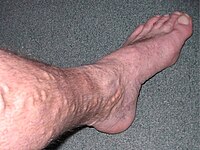
Photo from wikipedia
Gastric varices occur in 15% to 20% of patients with portal hypertension and are associated with significant GI bleeding and high mortality. Here, we report our experience with EUS-guided coil… Click to show full abstract
Gastric varices occur in 15% to 20% of patients with portal hypertension and are associated with significant GI bleeding and high mortality. Here, we report our experience with EUS-guided coil embolization and injection of absorbable gelatin sponge for the treatment of gastric varices (Video 1, available online at www.VideoGIE.org). A 51-year-old woman with decompensated alcoholic cirrhosis and known type 1 gastric varices presented to the hospital with hematemesis. She was deemed not a suitable candidate for either transjugular intrahepatic portosystemic shunt or balloon-occluded retrograde transvenous obliteration. It was, therefore, decided to offer EUSguided treatment of her gastric varices (Fig. 1). On EUS, 4 large collections of gastric varices were visualized, each with multiple individual compartments measuring 7 to 12 mm in short axis. Multiple varices were seen to directly contact the surface of the gastric fundus. Using a 19-gauge EUS needle, a collection of gastric varices was punctured in a transesophageal fashion, followed by deployment of multiple 20-mm 14-cm and 20-mm 7-cm embolization coils (0.035 inch Nestor; Cook Medical, Bloomington, Ind, USA). After coil embolization, there was immediate obliteration of Doppler flow. After multiple coils were deployed, injections of contrast material were performed to rule out a gastrorenal shunt. Injection of absorbable gelatin sponge (Gelfoam; Pfizer, New York, NY, USA), prepared into liquid slurry, was then performed to further enhance variceal eradication. The entire process was repeated until all 4 collections of gastric varices were eradicated. In total, 8 coils were deployed, and 5 mL of gelatin slurry was injected. The patient tolerated the procedure well and has not experienced any recurrent bleeding on clinical follow-up. Repeat surveillance EUS after 4 months demonstrated complete obliteration of her gastric varices. Endoscopic options are limited in patients with bleeding gastric varices. Cyanoacrylate injection has multiple disadvantages, which include solidifying within the injection needle, potential for endoscope damage, inadvertently unroofing the varices if the glue polymerizes on the needle tip during injection, and systemic embolization especially when mixed with lipiodol. Coil emboliza-
Journal Title: VideoGIE
Year Published: 2019
Link to full text (if available)
Share on Social Media: Sign Up to like & get
recommendations!